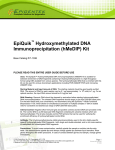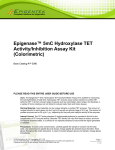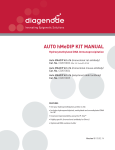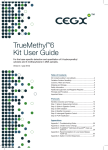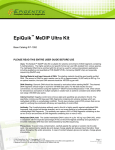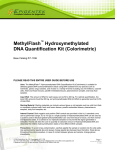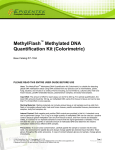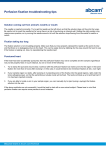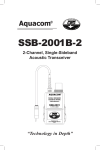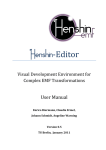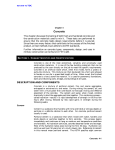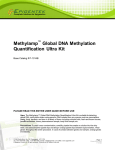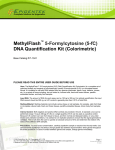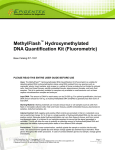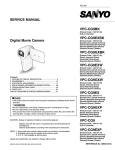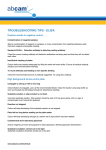Download hMeDIP - Abcam
Transcript
ab117134 EpiSeeker Hydroxymethylated DNA Immunoprecipitation (hMeDIP) Kit Instructions for Use For selective enrichment of DNA fragments containing 5-hydroxymethylcytosine in a high throughput format using DNA isolated from various species This product is for research use only and is not intended for diagnostic use. 1 Table of Contents 1. Overview 3 2. Background 7 3. Components and Storage 10 4. Protocol 12 5. Troubleshooting 18 6. Related Products 21 2 1. Overview EpiSeeker hydroxymethylated DNA Immunoprecipitation (hMeDIP) Kit contains all reagents required for carrying out a successful hMeDIP procedure using DNA isolated from mammalian cells or tissues. This kit includes a positive control DNA fragment, a negative control non-immune IgG, and control primers that can be used with the positive control to demonstrate the enrichment efficacy for hydroxymethylated DNA with the kit reagents and protocol. The positive control DNA containing 5-hmC can be immunoprecipitated by a 5-hmC antibody but not by a non-immune IgG. In this hMeDIP, immunoprecipitation of 5-hmC-enriched DNA fragments is processed in a microplate under optimized reaction conditions, which enables hMeDIP to be completed within 3 hours with high efficiency. Immunoprecipitated hydroxymethylated DNA is then cleaned, released, and eluted. Eluted DNA can be used for various downstream applications including PCR (hMeDIP-PCR) and microarray (hMeDIP-chip). 3 Selective enrichment of hydroxymethyated DNA with ab117134. 50 pg of unmethylated, methylated, and hydroxymethylated DNA control were each spiked into fragmented human genomic DNA (500 ng). hMeDIP was processed with the 5-hmC antibody and non-immune IgG included in the kit. Eluted DNA was analyzed by real time PCR with the control primers included in the kit to detect the presence of spiked control DNA. Foldenrichment represents the amount of recovered control DNA and was calculated based on the Cts. 4 Sensitive detection of gene-specific hydroxymethylation by hMeDIP-QPCR. Human brain DNA (500 ng) was fragmented to 200-600 bps with a sonicator. The fragmented DNA was used for hydroxymethylated DNA enrichment with the hMeDIP Kit. Eluted DNA was analyzed by real time PCR with primers specifically for OCT4 or GAPDH sequences in the promoter regions. Results show that the promoter region is hydroxymethylated in OCT4 but not in GAPDH. Fold-enrichment represents the amount of recovered DNA and was calculated based on the Cts. ab117134 is suitable for selective enrichment of DNA fragments containing 5-hydroxymethylcytosine in a high throughput format using DNA isolated from various species. The hydroxymethylated DNA that is enriched with this kit can be used for various downstream applications including PCR (hMeDIP-PCR) and microarray (hMeDIP-chip). 5 The starting material should be good quality purified DNA. The amount of DNA for each reaction can be 0.1 µg (approximately 1 x 4 10 cells) to 1 µg. For an optimal reaction, the input DNA amount should be 0.5 µg per well. Genomic DNA should be sheared by sonication before starting hydroxymethylated DNA immunoprecipitation. The sheared DNA fragments should range in size from 200-600 base pairs. Negative (Non-Immune IgG) and positive controls (Control DNA) are provided in this kit. The Control DNA is a 200 base pair DNA fragment containing 44 cytosine residues which are hydroxymethylated. The kit also includes control PCR primers that can be used for verifying the enrichment efficiency of hydroxymethylated control DNA. The 5-hydroxymethylcytosine rabbit polyclonal antibody used in this kit is highly specific against hydroxymethylated DNA fragments and is not cross-reactive to methylated and unmethylated DNA fragments. To avoid cross-contamination, carefully pipette the sample or solution into the strip wells. Use aerosol-barrier pipette tips and always change pipette tips between liquid transfers. Wear gloves throughout the entire procedure. In case of contact between gloves and sample, change gloves immediately. 6 2. Background DNA methylation occurs by the covalent addition of a methyl group at the 5-carbon of the cytosine ring, resulting in 5-methylcytosine (5mC). In somatic cells, 5-mC is found almost exclusively in the context of paired symmetrical methylation of the dinucleotide CpG, whereas in embryonic stem (ES) cells, a substantial amount of 5-mC is also observed in non-CpG contexts. The biological importance of 5-mC as a major epigenetic modification in phenotype and gene expression has been widely recognized. Quite recently, a novel modified nucleotide called 5-hydroxymethylcytosine (5-hmC) has been detected to be abundant in mouse brains and embryonic stem cells. In mammals, it can be generated by the oxidation of 5-methylcytosine, a reaction mediated by the Tet family of enzymes and DNMT proteins. It is a hydroxylated and methylated form of cytosine. 7 A line of evidence showed that 5-hmC also plays an important and different role from 5-mC in regulation of DNA methylation, chromatin remodeling, and gene expression, particularly in brain-specific gene regulation. For example, it was shown that 5-hmC inhibits the binding of the methyl-CpG binding domain proteins to DNA, suggesting a potential gene regulatory function of 5-hmC. 5-hmC was observed to be linked with epigenetic reprogramming in mammalian zygotes. However, the exact functions of 5-hmC have not yet been fully identified since gene-specific distribution of 5-hmC is unknown due to the inability of currently used DNA methylation analysis methods in distinguishing 5-hmC from 5-mC Because of the presence of 5-hmC in DNA with unclear functions in gene regulation and because of the discovery of enzymes that produce 5-hmC, it is crucial to identify hydroxymethylation status in specific gene loci, which would help to better understand methylation-based epigenetic regulation of gene functions. To achieve this, an innovative method has been developed to capture DNA fragments containing 5-hmC, and this method has been incorporated into the EpiSeeker hydroxymethylated DNA Immunoprecipitation (hMeDIP) Kit. This kit uses a high affinity 5hmC antibody to selectively capture double-stranded or single stranded DNA fragments containing 5-hmC. 8 The kit has the following features: • Extremely fast and convenient protocol with a total procedure time (from input sample to ready-to-use hydroxymethylated DNA) of less than 3 hours, which includes a minimal handling time of less than 20 minutes. • Flexible 96 strip well microplate format makes the assay very easy to handle: manual method with one reaction at a time or high throughput method with 96 reactions at a time. • Highly efficient enrichment ratio of positive/negative control > 1000. • Low DNA input requirement of as low as 0.1 µg per reaction. • High reproducibility through pre-optimized hMeDIP conditions. • Compatible with various downstream analysis workflows including hMeDIP-PCR and hMeDIP-chip. 9 3. Components and Storage A. Kit Components Item Quantity (24 tests) Quantity (48 tests) Quantity (96 tests) EMH1 (10X Wash Buffer) 5 mL 10 mL 20 mL EMH2 (Antibody Buffer) 4 mL 8 mL 16 mL EMH3 (hMeDIP Solution) 3 mL 6 mL 12 mL EMH4 (DNA Release Buffer) 7 mL 14 mL 28 mL EMH5 (Non-Immune IgG, 0.6 mg/ml)* 10 µL 20 µL 40 µL EMH6 (5-hmC Antibody, 0.6 mg/ml)* 25 µL 50 µL 100 µL EMH7 (Control DNA, 500 ng/ml)* 5 µL 10 µL 20 µL EMH8 (Proteinase K, 10 mg/ml)* 28 µL 56 µL 112 µL EMH9 (Control Primer-Forward, 20 µM)* 5 µL 10 µL 20 µL EMH10 (Control Primer-Reverse, 20 µM)* 5 µL 10 µL 20 µL 8-Well Assay Strips (With Frame) 3 6 12 Adhesive 8-Well Strip Film 3 6 12 *Spin the solution down to the bottom prior to use. 10 B. Additional Materials Required • Variable temperature waterbath or incubator oven • Thermalcycler with 48- or 96-well block • Sonication device • Orbital shaker • Adjustable pipette and multiple-channel pipette • Aerosol resistant pipette tips • Parafilm M • 0.2 ml or 0.5 ml PCR vials C. Storage • Store EMH7 at –20°C away from light. • Store EMH1, EMH5, EMH6, EMH8, EMH9, EMH10, and 8-Well Assay Strips at 4°C away from light. • Store remaining components at room temperature away from light. • All components of the kit are stable for 6 months from the date of shipment, when stored properly. Note: Check if EMH1 contains salt precipitates before use. If so, briefly warm at room temperature or 37°C and shake the buffer until salts are re-dissolved. 11 4. Protocol Protocol Summary DNA shearing hmeDNA/antibody immunoprecipitation Release of hmeDNA from hmeDNA/Ab complex Elution of hmeDNA PCR, microarray, or similar downstream application A. Starting Materials • Input DNA Amount: DNA amount can range from 100 ng - 1 µg per reaction. An optimal amount is 500 ng per reaction. • DNA Isolation: You can use your method of choice for DNA isolation. • DNA Storage: Isolated genomic DNA can be stored at 4°C (short term) or –20°C (long term) until use. 12 B. Preparation of 1x Wash Buffer 1. Prepare Diluted EMH1 1X Wash Buffer: Add 5 ml of EMH1 10X Wash Buffer to 45 ml of distilled water (pH 7.2-7.5). This Diluted EMH1 1X Wash Buffer can now be stored at 4°C for up to six months. C. Preparation of Antibody Coated Wells 1. Predetermine the number of strip wells required for your experiment. Carefully remove un-needed strip wells from the plate frame and place them back in the bag (seal the bag tightly and store at 4°C).. 2. Add 100 µl of EMH2 to each well and then add the following antibodies: 1 µl of EMH5 to the negative control well, 1 µl of EMH6 to the sample wells, and 1 µl of EMH6 to the positive control wells. 3. Cover the wells with parafilm M and incubate at room temperature for 60 min. Meanwhile, prepare fragmented DNA as described in the next step. D. Shearing of Genomic DNA 1. For the best results, DNA should be fragmented by a suitable sonication method: 13 a. Probe-based Sonication: You will need to optimize the sonication settings. For example, DNA of 200-1000 bp size can be obtained by sonicating 3-4 pulses of 10-12 sec each at level 2 using a microtip probe, followed by a 30-40 sec rest period on ice between each pulse. b. Waterbath-based Sonication: Follow the manufactuerer’s user manual for DNA shearing at a size range of 200-600 bp. Note: If desired, remove 10 µl of sheared DNA for purification and agarose gel analysis along with a DNA marker on a 1-2% agarose gel, stained with ethidium bromide. Visualize it under ultraviolet light. E. Preparation of hMeDIP Reaction 1. Remove EMH2 from the wells and wash the wells two times with 200 µl of Diluted EMH1 each time. 2. Dilute the EMH7 (Control DNA) to 50 ng/ml (50 pg/µl) by adding 1 µl of EMH7 to 9 µl of EMH3 hMeDIP Solution and dilute your sample DNA with EMH3 hMeDIP Solution to 10 µg/ml (10 ng/µl). Setup the hMeDIP reactions by adding the appropriate reagents to each corresponding well according to the following chart. 14 Reagents Sample Positive Negative Negative well Control Control Control Well Well Well for for Control Sample DNA EMH3 50 µL 99 µL 50 µL 99 µL Sample DNA 50 µL N/A 50 µL N/A EMH7 0 µL 1 µL 0 µL 1 µL Note: (1) The final amount of each component should be 500 ng/well for sample DNA and 50 pg/well for control DNA; (2) An input DNA control is only used for estimating enrichment efficiency of hMeDIP and is generally not needed as the included positive and negative controls can be used for estimating the same objective more accurately; (3) If an input DNA control is to also be included, remove 5 µl of the sonicated DNA solution prepared at Step D to a 0.5 ml vial, label as “input DNA”, and place on ice. 3. Cover the wells with parafilm M and incubate at room temperature for 90 min on an orbital shaker at 50100 rpm. 15 F. Wash of the Reaction Wells 1. Carefully remove and discard the solution containing the reagents by pipetting out each well. 2. Thoroughly wash each well five times with 200 µl of the Diluted EMH1 each time. This can be done by simply pipetting Diluted EMH1 in and out of the wells. 3. Wash each well with 200 µl of EMH4 one time by pipetting EMH4 in and out. G. Release and Elution of DNA 1. Prepare EMH4-EMH8 Solution by adding 1 µl of EMH8 to every 39 µl of EMH4. Mix. 2. Add 40 µl of the EMH4-EMH8 Solution to each well. 3. Separate and insert the wells into a thermalcycler with a 48 well block. 4. Tightly seal the wells with Adhesive 8-Well Strip Film and incubate at 60°C for 15 min, followed by incubation at 95°C for 3 min. 16 Note: If only a thermalcycler with a 96 well block is available, then: (1) incubate the wells at 65°C for 20 min and quickly transfer the DNA solution from each well to 0.2 ml strip PCR tubes. Cap the PCR tubes and then incubate the PCR tubes containing the DNA solution at 95°C for 3 min in the thermalcycler; (2) place the PCR tubes in room temperature. If liquid is collected on the inside of the caps, briefly centrifuge the liquid down to the bottom. DNA is now ready for use or storage at –20°C. For real time PCR analysis, we recommend using 1-2 µl of eluted DNA in a 20 µl PCR reaction. Input DNA can be added directly to a PCR reaction after appropriate dilution. For end point PCR, the number of PCR cycles may need to be optimized for better PCR results. In general, the amplification difference between “EMH5” and “EMH6” may vary from 3 to 8 cycles, depending on experimental conditions. For hMeDIP-chip, additional DNA cleanup/concentration and whole genome amplification (WGA) steps may be needed. 17 5. Troubleshooting Problem Cause Solution Little or no PCR products generated from samples. Poor DNA quality due to insufficient cell amounts, extraction, or degradation. To obtain the best results, the amount of DNA per hMeDIP should be 0.1-1 µg with 260/280 ratio >1.6. Inappropriate DNA fragmenting conditions. DNA fragment size should be between 2001000 bp with an optimal size range of 200-600 bp. Oversized DNA fragments may reduce targeted DNA capturing via antibody and undersized DNA fragments may decrease PCR efficiency. Incorrect temperature and/or insufficient time during DNA release. Ensure the incubation time and temperature described in the protocol are followed correctly. Improper PCR program settings. Ensure PCR program settings are properly programmed. Inappropriate PCR reaction solution. If using a homemade PCR reaction solution, check if each component is correctly mixed. If using a PCR Fast Kit, check if it is suitable for your PCR. Little or no PCR products generated from samples. 18 Problem Cause Solution Little or no PCR products generated from samples. Inappropriate primers. Confirm the species specificity of your primers. Primers should be designed to cover a short sequence region (70-150 bp) for more efficient and exact amplification of target DNA regions. Improper sample storage. DNA samples should be stored at –20°C (3-6 months). Insufficient washing of wells. Check if washing recommendations at each step is performed according to the protocol. If the signal intensity in the negative control is still high, washing stringency can be increased in the following ways: 1. Increase wash time at each wash step: after adding Diluted EMH1, leave it in the tubes/wells for 2-3 min before removing it. 2. Add an additional one or two wash steps: The volume of Diluted EMH1 is sufficient for at least two extra washes for each sample. No difference in signal intensity between negative control and positive control 19 Problem Cause Solution No difference in signal intensity between negative control and positive control Too many PCR cycles. Plateau phase of amplification caused by over-increased number of PCR cycles in endpoint PCR may mask the difference in signal intensity between negative control and positive control. Decreasing the number of PCR cycles (ex: 3235 cycles) to keep amplification at exponential phase will reduce high background in endpoint PCR and allow differences in amplification to be seen. Real time PCR is another alternative in such cases. Little or No PCR products generated from positive control only PCR conditions are not optimized. Make sure the PCR conditions include correct and appropriate temperature, cycles, and solutions. For further technical questions please do not hesitate to contact us by email ([email protected]) or phone (select “contact us” on www.abcam.com for the phone number for your region). 20 6. Related Products EpiSeeker methylated DNA Immunoprecipitation (MeDIP) Kit DNA (ab117133) EpiSeeker methylated DNA Immunoprecipitation (MeDIP) Kit (ab117135) EpiSeeker methylated DNA Immunoprecipitation (MeDIP) Kit Tissue (ab117136) EpiSeeker hydroxymethylated DNA Quantification Kit DNA Quantification Kit (Colorimetric) (ab117130) EpiSeeker hydroxymethylated (Fluorometric) (ab117131) 21 22 UK, EU and ROW Email: [email protected] Tel: +44 (0)1223 696000 www.abcam.com US, Canada and Latin America Email: [email protected] Tel: 888-77-ABCAM (22226) www.abcam.com China and Asia Pacific Email: [email protected] Tel: 108008523689 (中國聯通) www.abcam.cn Japan Email: [email protected] Tel: +81-(0)3-6231-0940 www.abcam.co.jp Copyright © 2012 Abcam, All Rights Reserved. The Abcam logo is a registered trademark. 23 All information / detail is correct at time of going to print.
























